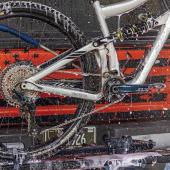Keep the Rubber on the Road
Winter driving around the Bozone.
I’m a cheapskate, so naturally I have always tried to eke out as many miles on my car’s tires as I could. Then one day I went over the Bozeman pass sideways.
When I left home early that morning, the weather was a little wet, but as I climbed the hill and the temperature dropped, the road surface got nasty. I felt proud of myself for slowing to 45 through the slush, then all the way down to a doddering 30 miles an hour as it turned to ice. Cresting the top of the pass, the ice turned back to slush, and very little of it. I slowly sped up, to about 35 or 40, when without warning the back end of my Subaru wandered off to the left. The Suby lost traction completely and slid sideways for about 100 feet before coming to rest on the shoulder—luckily, without injury to me or the car.
Now I get new tires as soon as I notice significant wear. I really could have learned this lesson the easy way, from a friend who worked for several years as a truck driver and became an evangelist for good rubber on vehicles. He’s not financially well off—he drives a well-used vehicle that he maintains himself—but his tires are worth more than the whole rest of the rig.
What makes your car go? Most people would say it’s the engine, or maybe the liquid gold we put in the fuel tank. Your local
physicist would tell you, however, that what makes your car go is the friction between tires and pavement when a rotational force is applied. Yep. Your tires make your car go.
Conversely, what makes your car stop, under normal circumstances, is not the tires, but the conversion of energy in the rolling wheels and axles into heat energy—the job done by your brakes squeezing on the rolling parts.
Under not-so-normal conditions, like emergency stopping, the tires cease rolling on the pavement and start to slide or skid. In this situation, the tires do need to drag on the pavement surface, in order to slow the forward motion of your car. The tires also need to have solid contact when the car is cornering and there is lateral pressure on the vehicle. If there’s ice or water between the rubber and the pavement, your tires won’t grip and it’s goodbye traction, from fishtailing to an all-out spin.
When the tire tread wears, your tires lose the ability to reach the pavement through snow and the ability to channel water out from between rubber and pavement. Both of these lead to poor braking under urgent situations or loss of control when there is lateral pressure on the tires. Consumer Reports has tested worn tires and documented a 15% decrease in snow traction and 7%-8% decrease in wet braking at 50% treadwear.
Snow is coming—now is the time to check your tires for wear. Don’t wait for baldness to set in or a sideways trip to Livingston to tell you need new tires. Replace them well before the tread wears down to the indicator bars.
Dean Center, M.D., is a former physician at Family Doctors Urgent Care in Bozeman.












